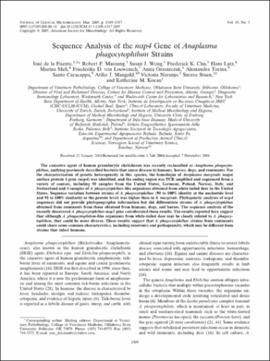| dc.contributor.author | de la Fuente, Jose | |
| dc.contributor.author | Massung, Robert F. | |
| dc.contributor.author | Wong, Susan J. | |
| dc.contributor.author | Chu, Frederick K. | |
| dc.contributor.author | Lutz, Hans | |
| dc.contributor.author | Meli, Marina | |
| dc.contributor.author | von Loewenich, Friederike D. | |
| dc.contributor.author | Grzeszczuk, Anna | |
| dc.contributor.author | Torina, Alessandra | |
| dc.contributor.author | Caracappa, Santo | |
| dc.contributor.author | Mangold, Atilio J. | |
| dc.contributor.author | Naranjo, Victoria | |
| dc.contributor.author | Stuen, Snorre | |
| dc.contributor.author | Kocan, Katherine M. | |
| dc.date.accessioned | 2015-10-16T20:48:26Z | |
| dc.date.available | 2015-10-16T20:48:26Z | |
| dc.date.issued | 2005-03 | |
| dc.identifier | okds_Kocan_JCM_2005-03.pdf | |
| dc.identifier.citation | de la Fuente, J., Massung, R. F., Wong, S. J., Chu, F. K., Lutz, H., Meli, M., ... Kocan, K. M. (2005). Sequence analysis of the msp4 gene of Anaplasma phagocytophilum strains. Journal of Clinical Microbiology, 43(3), 1309-1317. https://doi.org/10.1128/jcm.43.3.1309-1317.2005 | |
| dc.identifier.uri | https://hdl.handle.net/11244/19919 | |
| dc.description.abstract | The causative agent of human granulocytic ehrlichiosis was recently reclassified as Anaplasma phagocytophilum, unifying previously described bacteria that cause disease in humans, horses, dogs, and ruminants. For the characterization of genetic heterogeneity in this species, the homologue of Anaplasma marginale major surface protein 4 gene (msp4) was identified, and the coding region was PCR amplified and sequenced from a variety of sources, including 50 samples from the United States, Germany, Poland, Norway, Italy, and Switzerland and 4 samples of A. phagocytophilum-like organisms obtained from white-tailed deer in the United States. Sequence variation between strains of A. phagocytophilum (90 to 100% identity at the nucleotide level and 92 to 100% similarity at the protein level) was higher than in A. marginale. Phylogenetic analyses of msp4 sequences did not provide phylogeographic information but did differentiate strains of A. phagocytophilum obtained from ruminants from those obtained from humans, dogs, and horses. The sequence analysis of the recently discovered A. phagocytophilum msp2 gene corroborated these results. The results reported here suggest that although A. phagocytophilum-like organisms from white-tailed deer may be closely related to A. phagocytophilum, they could be more diverse. These results suggest that A. phagocytophilum strains from ruminants could share some common characteristics, including reservoirs and pathogenicity, which may be different from strains that infect humans. | |
| dc.format | application/pdf | |
| dc.language | en_US | |
| dc.publisher | American Society for Microbiology | |
| dc.rights | This material has been previously published. In the Oklahoma State University Library's institutional repository this version is made available through the open access principles and the terms of agreement/consent between the author(s) and the publisher. The permission policy on the use, reproduction or distribution of the material falls under fair use for educational, scholarship, and research purposes. Contact Digital Resources and Discovery Services at lib-dls@okstate.edu or 405-744-9161 for further information. | |
| dc.title | Sequence analysis of the msp4 gene of Anaplasma phagocytophilum strains | |
| osu.filename | okds_Kocan_JCM_2005-03.pdf | |
| dc.description.peerreview | Not peer reviewed | |
| dc.identifier.doi | 10.1128/JCM.43.3.1309-1317.2005 | |
| dc.description.department | Veterinary Pathobiology | |
| dc.type.genre | Article | |
| dc.type.material | Text | |
